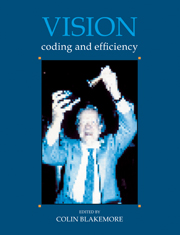Book contents
- Frontmatter
- Contents
- List of Contributors
- Preface
- Reply
- Acknowledgements
- Concepts of coding and efficiency
- Efficiency of the visual pathway
- Colour
- Brightness, adaptation and contrast
- Development of vision
- 19 On reformation of visual projection: cellular and molecular aspects
- 20 Retinal pathways and the developmental basis of binocular vision
- 21 Development of visual callosal connections
- 22 Sensitive periods in visual development: insights gained from studies of recovery of visual function in cats following early monocular deprivation or cortical lesions
- 23 The developmental course of cortical processing streams in the human infant
- 24 Maturation of mechanisms for efficient spatial vision
- 25 The puzzle of amblyopia
- Depth and texture
- Motion
- From image to object
- Index
23 - The developmental course of cortical processing streams in the human infant
Published online by Cambridge University Press: 05 May 2010
- Frontmatter
- Contents
- List of Contributors
- Preface
- Reply
- Acknowledgements
- Concepts of coding and efficiency
- Efficiency of the visual pathway
- Colour
- Brightness, adaptation and contrast
- Development of vision
- 19 On reformation of visual projection: cellular and molecular aspects
- 20 Retinal pathways and the developmental basis of binocular vision
- 21 Development of visual callosal connections
- 22 Sensitive periods in visual development: insights gained from studies of recovery of visual function in cats following early monocular deprivation or cortical lesions
- 23 The developmental course of cortical processing streams in the human infant
- 24 Maturation of mechanisms for efficient spatial vision
- 25 The puzzle of amblyopia
- Depth and texture
- Motion
- From image to object
- Index
Summary
Introduction
The work of Horace Barlow, his colleagues and his students has not only made us consider the efficiency of the visual system in encoding significant properties of the visual world it has also focused attention on the question: how did the visual system get that way? Initially, the most promising approach appeared to be through experimental manipulations in the visual development of animals, and the continuing fruits of that approach can be sampled elsewhere in this volume. However, in the last decade and a half it has also been realized that human infants can tell us a great deal about the development of their visual systems, if we use the right techniques. It turns out that this development is particularly rapid over the first few months of life. One aspect of this is a quantitative improvement in many aspects of visual performance. However, there are also radical qualitative changes, which we will argue show the progressive emergence of functions of the visual cortex.
The basis of developments in spatial visual performance
Visual scientists' first questions about infant development were concerned with acuity and contrast sensitivity, and used measures of grating detection from behaviour in forced-choice preferential looking (FPL) and from visual evoked potentials (see reviews by Dobson & Teller, 1978; Atkinson & Braddick 1981; Atkinson, 1984; Banks & Salapatek, 1983). There are some differences still to be resolved, particularly between earlier estimates of newborn performance and those recently reported from the ‘sweep VEP’ method (Norcia & Tyler, 1985).
- Type
- Chapter
- Information
- VisionCoding and Efficiency, pp. 247 - 253Publisher: Cambridge University PressPrint publication year: 1991
- 2
- Cited by



